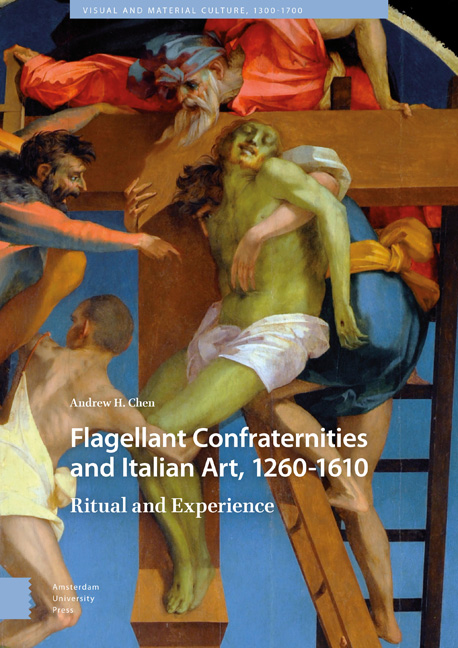Book contents
- Frontmatter
- Deduction
- Contents
- Abbreviations
- List of Illustrations
- Acknowledgements
- Introduction
- Part I Art and Ritual, to 1450
- 1 Flagellation and Its Settings
- 2 Images at Entrances, and Ascesis
- 3 Mass
- 4 Comforting
- 5 Processions
- Part II Transformations
- 6 Changes in Ritual Before Trent
- 7 Changes in imagery before Trent: Sansepolcro and Volterra
- 8 After Trent: Florence and Milan
- Epilogue: Global Flagellation
- Bibliography
- Index of Illuminated Manuscripts (by location)
- Index of Paintings (by location)
- Index of Topics
- Frontmatter
- Deduction
- Contents
- Abbreviations
- List of Illustrations
- Acknowledgements
- Introduction
- Part I Art and Ritual, to 1450
- 1 Flagellation and Its Settings
- 2 Images at Entrances, and Ascesis
- 3 Mass
- 4 Comforting
- 5 Processions
- Part II Transformations
- 6 Changes in Ritual Before Trent
- 7 Changes in imagery before Trent: Sansepolcro and Volterra
- 8 After Trent: Florence and Milan
- Epilogue: Global Flagellation
- Bibliography
- Index of Illuminated Manuscripts (by location)
- Index of Paintings (by location)
- Index of Topics
Summary
Most of the time, laypeople did not physically ingest the sacrament when they attended Mass; reception was visual. The Host was the ephemeral image which stood at the centre of the ritual. When the celebrant consecrated the wafer by pronouncing Hoc est corpus meum, the body of Christ became present; then followed the climactic visual moment when the consecrated Host was elevated for all to see. Crucifixes aligned with altars shaped imaginative conceptions of this body and provided points of departure for meditations on the sacrifice that was being reconstituted at the altar. Other meanings could be called to mind: the significance of God becoming flesh; the redemptive power of Christ's sacrifice; the possibility of triumph over death through Christ.
Flagellant confraternities encouraged members to confess and take communion, and they organized their own masses to observe certain feasts, remember the dead, and stage interactions with the body of Christ. Confraternities thus had great control over the circumstances in which people experienced this programme of ostension and reverence that stood at the centre of lived religion. The timings and settings determined by these societies radically inflected the meaning of these rituals. Flagellant confraternities, unlike institutions of a particular order, had no common rite. There is a local flavour to all of the calendars discussed in this chapter. Confraternal policies regarding key feasts like Easter are inconsistent. Elucidating the particularities can throw light on the function and experience of art. Figuring out the occasions on which an altarpiece served as backdrop, for example, can allow us to understand more precisely what the imagery meant to audiences of the period.
During Mass, missals were propped open on altars, illuminated by candlelight. Service books were bookmarked by their decoration. Some were lavishly illuminated. Often the confraternal provenance of these books is indicated by donor pictures on the opening folio. Calendars, hierarchy of decoration, and style can localize the book and potentially even identify its patrons. The second part of this chapter demonstrates how these kinds of evidence suggest a Bolognese provenance for a magnificent, but heretofore under-researched, illuminated missal.
The Sienese confraternity discussed in the last chapter acquired, toward the beginning of the fourteenth century, a more modest decorated missal, which remains in the archive of the Societa di Esecutori di Pie Disposizioni di Siena, the present-day incarnation of the confraternity.
- Type
- Chapter
- Information
- Flagellant Confraternities and Italian Art, 1260–1610Ritual and Experience, pp. 104 - 122Publisher: Amsterdam University PressPrint publication year: 2018

